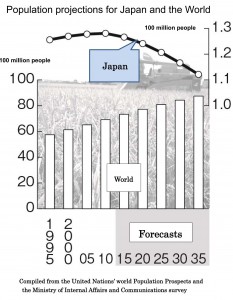As the government works to revise its basic plan for food, agriculture and rural areas, the main focus will be how to cope with the aging and population decline of the country and strengthen its food production capability.
Due to the downward trend in population and the rapidly aging farm sector, the weakening of the nation’s food security has become more serious than ever.
For Japan which depends on foreign countries for 60 percent of its food supply, raising the food self-sufficiency ratio remains the top priority issue, but it is also becoming increasingly important to consider the issue from the business side of farming.
“It will be the first revision of the plan to be made after Japan’s population has shown a clear downward trend,” said Yasuhiro Nakashima, professor at the University of Tokyo’s graduate school and head of the Ministry of Agriculture, Forestry and Fisheries’ panel to revise the plan. “We need to discuss the plan from a viewpoint of longer term than usual, taking into account future social changes.”
The government plans to come up with the new basic plan, which is revised every 10 years, in 2015. In 2025, the nation’s population decline is highly likely to be accelerating even further.
According to predictions by the National Institute of Population and Social Security Research, Japan’s population will total 126.6 million in 2015, down 2 percent from 2010. The institute predicts the population growth which continued until 2010 will take a downward turn and the population will drop below 120 million in 30 years.
If the population shrinks, the amount of necessary food supply will drop, but the nation’s agriculture sector will also weaken. Even now, 60 percent of 1.74 million people mainly engaged in agriculture are aged 65 or older. While more than half of the nation’s farms are operated by the elderly, only 10 percent of the farms are run by people younger than 50, the generation to become main food suppliers in the future.
The main issue in revising the basic plan will be how to secure stable food supply under such circumstances. In addition to setting targets for food self-sufficiency rates and food production capacity, it will become especially important to clearly indicate measures to maintain and improve the capacity and implement them.
Practical goal for food self-sufficiency
Under the current plan, the target for the food self-sufficiency rate on a calorie basis is 50 percent in 2020, but the rate was 39 percent in 2012. A large gap exists between the target rate and the status quo, and the rate has been on a gradual decrease since marking 41 percent in 2008. In revising the basic plan, some members of the ministry’s panel and the ruling Liberal Democratic Party are calling for the need to set a new target which is feasible.
Shinichi Shogenji, professor of Nagoya University’s graduate school and a member of the ministry’s panel, questions the way the current target is defined, which is “a high target which can be met only by using every available resource.” He stresses that the new target should be set by taking into consideration all the possible factors including changes in people’s diet and the situation of the agricultural sector.
The ministry also cites a drastic change in people’s eating habits as a cause of decline in self-sufficiency. It explains that as a long-term trend, people are eating less rice with high self-sufficiency ratio and eating more dairy products with lower self-sufficiency rate.
Viewpoint of farmers is inevitable in setting a food self-sufficiency target. Akira Banzai, head of the Central Union of Agricultural Co-operatives, called on the members of the panel to evaluate the target from the commercial aspect of agricultural management, in addition to the aspects of population and dietary changes. The ministry analyzes that the reason behind declining self-sufficiency rate is the farmers’ failure to cope with changes in consumption trends, but Banzai points out the need to analyze from various angles why farmers could not respond to the changes.
Getting ready for tightening of global supply-demand balance
 Another focus will be on how to define self-sufficiency. The ministry defines it as “potential food supply capacity” to prepare for unexpected situations, considering that Japan’s food supply is highly dependent on imports. The ministry hopes to clarify the definition in the process of revising the plan and seek measures to maintain and improve the capacity.
Another focus will be on how to define self-sufficiency. The ministry defines it as “potential food supply capacity” to prepare for unexpected situations, considering that Japan’s food supply is highly dependent on imports. The ministry hopes to clarify the definition in the process of revising the plan and seek measures to maintain and improve the capacity.
Ministry officials fear that the nation’s food supply could face risks in the future, as the global population, unlike Japan’s population, is steadily increasing.
According to the United Nations’ estimates, the world’s population topped 7 billion in 2012 and will reach 8 billion in 2025. While global food supply-demand balance is predicted to tighten along with the increasing population, farmers and farmlands in Japan are continuing to decline.
The ministry plans to discuss measures to improve the nation’s food production capacity from three aspects – a. agricultural resources such as farmlands and irrigation, b. people engaged in farming and c. agricultural technology.
Members of the panel share the view that Japan’s food production capacity should be strengthened, and plan to discuss the issue further. Some are calling for the need to set a target for raising the capacity, and other members say it is necessary to explain the situation clearly to the public.
The panel is scheduled to evaluate the current plan by July, and, based on the evaluation, start putting together a draft for the new plan in autumn and complete the revision in March.
(April 5, 2014)

